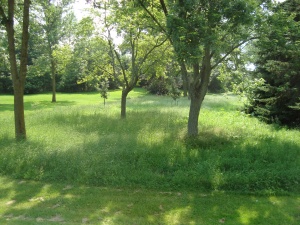Difference between revisions of "Turf"
Jump to navigation
Jump to search
Jenny Hill (talk | contribs) m |
Jenny Hill (talk | contribs) |
||
| Line 3: | Line 3: | ||
| − | ==Best practices | + | [[File:Example4.jpg|thumb|I have no information about this image]] |
| + | |||
| + | |||
| + | |||
| + | |||
| + | |||
| + | ==Best practices for mown turf== | ||
Close mowing removes leaves and increases shoot production, leading to a denser 'velvety' appearance. | Close mowing removes leaves and increases shoot production, leading to a denser 'velvety' appearance. | ||
But this 'damage' also reduces the plant's photosynthetic processes and stunts its growth. Notably, when grass is stressed by close pruning, it doesn't have the resources to develop deeper roots. The shallow roots in turf grass make it particularly susceptible to drought conditions and significantly weakens the resiliency of the grass. Any pruning (including mowing) introduces cut edges on the leaf blades, increasing the potential for disease. | But this 'damage' also reduces the plant's photosynthetic processes and stunts its growth. Notably, when grass is stressed by close pruning, it doesn't have the resources to develop deeper roots. The shallow roots in turf grass make it particularly susceptible to drought conditions and significantly weakens the resiliency of the grass. Any pruning (including mowing) introduces cut edges on the leaf blades, increasing the potential for disease. | ||
| Line 10: | Line 16: | ||
| − | |||
==External links== | ==External links== | ||
[http://www.omafra.gov.on.ca/english/crops/facts/08-025w.htm#turf OMAFRA on turf grasses] | [http://www.omafra.gov.on.ca/english/crops/facts/08-025w.htm#turf OMAFRA on turf grasses] | ||
Revision as of 16:43, 19 December 2017
Best practices for mown turf
Close mowing removes leaves and increases shoot production, leading to a denser 'velvety' appearance. But this 'damage' also reduces the plant's photosynthetic processes and stunts its growth. Notably, when grass is stressed by close pruning, it doesn't have the resources to develop deeper roots. The shallow roots in turf grass make it particularly susceptible to drought conditions and significantly weakens the resiliency of the grass. Any pruning (including mowing) introduces cut edges on the leaf blades, increasing the potential for disease.
